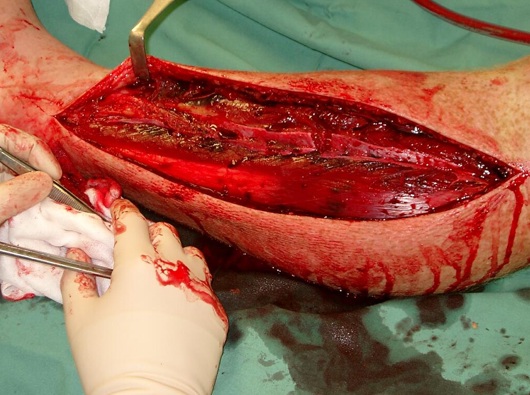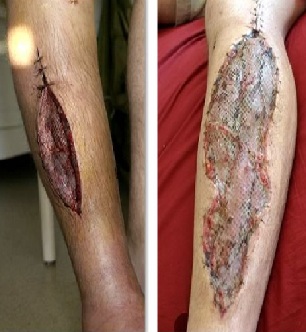Compartment Syndrome is a serious myopathy, or pathological condition of the muscles, that can cause acute pain, inflammation and even death in acute cases. Know all about this disease, including its possible causes, symptoms, diagnosis, treatment and prognosis.
Compartment Syndrome Definition
Page Contents
- 1 Compartment Syndrome Definition
- 2 Compartment Syndrome ICD9 Code
- 3 Compartment Syndrome Incidence
- 4 Compartment Syndrome Symptoms
- 5 Compartment Syndrome Types
- 6 Compartment Syndrome Causes
- 7 Compartment Syndrome Risk Factors
- 8 Compartment Syndrome Diagnosis
- 9 Compartment Syndrome Differential Diagnosis
- 10 Compartment Syndrome Treatment
- 11 Compartment Syndrome Prognosis
- 12 Compartment Syndrome Complications
- 13 Compartment Syndrome Prevention
Compartment Syndrome is an acute disease characterized by increased pressure inside a muscle compartment which can result in damage to the muscles and nerves and also cause problems in the flow of blood.
Compartment Syndrome ICD9 Code
The ICD9 codes for this disorder are 729.7 and 958.9.
Compartment Syndrome Incidence
The exact incidence of this condition is not known. However, the disease is supposed to be quite common in nature especially in athletes, aged people and those suffering from fractures.
Compartment Syndrome Symptoms
The condition gives rise to acute pain that refuses to subside even after taking analgesics (pain-relievers) or keeping the affected region elevated from other areas of the body. In more acute cases, the signs and symptoms may involve the following:
Picture 1 – Compartment Syndrome
- Paleness of skin
- Weakness
- Acute, worsening pain
- Tingling and numbness
- Reduced sensation
Compartment Syndrome Types
The condition has been categorized into two major types, which are:
Acute Compartment Syndrome
Regarded as a medical emergency, it is generally caused by an acute injury. In the absence of medical treatment, it can cause permanent damage to the muscles.
Chronic Compartment Syndrome
This is not generally a medical emergency. Also referred to as Exertional Compartment Syndrome, it is caused most frequently as a result of exertion during athletic activities.
Compartment Syndrome Causes
The causes for this condition differ on the basis of the type of the disorder that an individual suffers from.
Causes for Acute Compartment Syndrome
It usually arises after an acute injury, such as a broken bone or a car accident. In rare cases, it arises after a comparatively minor injury.
This type of Compartment Syndrome may also develop due to certain conditions, such as:
Crush injuries
Crushing injuries or traumas are one of the main factors responsible for this syndrome.
Fractures
Fractures, or breaks in the bones, are possibly the most common injury that can result in this syndrome. A fracture of the arm or leg is typically found to be the cause of this condition.
A badly bruised muscle
Such types of traumas can occur due to sudden blows to the leg, as may happen in cases of a fall from motorcycle or a collision of the foot with the helmet of a player.
Use of anabolic steroids
Intake of steroids is regarded as a possible factor in the development of this syndrome.
Use of tight bandages
Use of tight bandages and casts may also give rise to this problem. If the signs and symptoms of this syndrome arise, any bandage that is possibly constricting a nerve or muscle should be loosened or removed. A doctor should be contacted on an immediate basis if a cast is found to be the cause of this syndrome.
Re-established flow of blood after obstructed circulation, which may arise after surgical repair of a damaged blood vessel that has been obstructed for several hours. A blood vessel may also get blocked during sleep. Lying in a prolonged duration in a position that obstructs a blood vessel and then waking up or moving can result in this syndrome. The majority of healthy individuals would naturally move when flow of blood to a limb is obstructed at the time of sleeping. The occurrence of Compartment Syndrome in this way generally occurs in individuals with compromised nervous systems. This may occur after acute intoxication with drugs or alcohol.
Other possible causes for this syndrome include the following:
- Snake bites
- Strenuous exercise
- Burns
- Bleeding from an injured blood vessel
- Penetrating traumas such as gunshot wounds or stab wounds
- Intravenous medications, generally administered through a drip into a vein, which unknowingly leak within the arm surrounding the vein.
Causes of Chronic (Exertional) Compartment Syndrome
The inflammation and pain associated with this form of the syndrome arises as a consequence of exercise. Athletes participating in sporting activities like swimming, biking or running that require repetitive motions are more susceptible to chronic cases of this syndrome. Discontinuation of exercise generally helps bring relief to sufferers. The condition is not usually dangerous in nature.
Compartment Syndrome Risk Factors
The risk of development of this condition is increased in certain individuals. The risk-prone population includes:
Neourologically compromised individuals
As aforementioned, those suffering from neurological problems can suffer from circulatory obstructions while sleeping which can lead to Compartment Syndrome.
Athletes
Athletes and sportsperson are highly susceptible to all kinds of injuries, including the ones that can give rise to this syndrome.
Old individuals
Aged people, particularly those who suffer from one or more fractures, are also more prone to this syndrome. Those having fractures in the arm or leg are especially at greater risk of having this problem.
Compartment Syndrome Diagnosis
The diagnosis of this syndrome initially begins with a physical examination of sufferers. A physical examination is conducted to detect the presence or absence of the following problems:
- Inflammation in the affected region
- Painful sensations on squeezing the affected region
- Sensations of acute pain while moving the affected area
The diagnostic method differs according to the type of the condition that one suffers from.
Diagnosis for Acute Compartment Syndrome
Patients concerned about Acute Compartment Syndrome should immediately go to an emergency room to get themselves checked, as this is a medical emergency. Physicians tend to detect this form of the syndrome by measuring the compartment pressure in order to assess whether or not patients are suffering from the acute variety of the disorder.
Diagnosis for Chronic (Exertional) Compartment Syndrome
In order to diagnose this type, a doctor must rule out the presence of other disorders that can also cause pain in the lower leg. Physicians should conduct tests like applying pressure on the tendons to make sure sufferers do not have Tendonitis. They may order carrying out an X-ray to ensure that the shinbone (tibia) has not suffered a stress fracture.
In an attempt to confirm Chronic Compartment Syndrome, a doctor is likely to measure the pressure within the compartment before and after a workout (or any other activity that gives rise to painful sensations in patients). The measurement is done by using a needle affixed to a pressure meter that is placed into the affected area of the body. Patients are confirmed of having the chronic variety of the syndrome if pressures remain high after working out.
Compartment Syndrome Differential Diagnosis
The differential diagnosis for this syndrome involves isolating its signs from similar symptoms produced by other disorders. The differential diagnosis differs on the basis of the form of the disorder that an individual is suffering from.
Acute Compartment Syndrome Differential Diagnosis
It includes excluding its signs from those of disorders like:
- Cellulitis
- Cnidaria Envenomation
- Peripheral Vascular Injuries
- Deep Venous Thrombosis
- Gas Gangrene in Emergency Medicine
- Rhabdomyolysis in Emergency Medicine
- Emergent Management of Necrotizing Fasciitis
- Physical Medicine and Rehabilitation for Stress Fractures
Chronic Compartment Syndrome Differential Diagnosis
It involves isolating its signs from those of disorders like:
- Tumor
- Tenosynovitis
- Myopathies
- Spinal Stenosis
- Hypothyroid Myopathy
- Deep Venous Thrombosis
- Lumbosacral Radiculopathy
- Nerve Entrapment Syndromes
Physicians should ensure that patients are actually suffering from Compartment Syndrome and not any of the disorders mentioned above.
Compartment Syndrome Treatment
The treatment plan for this disorder is based on the form of the syndrome that individuals suffer from, i.e, acute or chronic.
Treatment for Acute Compartment Syndrome
There is no effective non-operative treatment for acute forms of this disorder which are regarded as surgical emergencies. Fasciotomy is the surgical treatment choice for this condition. In this method, surgeons make an incision and cuts open the skin as well as the fascia that forms a covering over the affected compartment.
In some cases, the inflammation can be acute enough for the skin opening to be closed immediately. When inflammation subsides, the incision can be surgically repaired. A skin graft is used in some cases.
Treatment for Chronic Compartment Syndrome
This form of the syndrome can be cured through surgical as well as non-surgical means.
Non-surgical treatment
This includes anti-inflammatory medications, physical therapy and orthotics (inserts for shoes), which have questionable results. The symptoms may subside by avoiding the activity that can cause the disorder. Cross-training with low-impact activities may yield some benefit. Certain athletes suffer from a worsening of symptoms on some kinds of surfaces (such as artificial turf or concrete). In such cases, they can obtain relief from symptoms by switching surfaces.
Surgical treatment
It may be an option if conservative measures fail to yield benefit. Surgical option is similar to that used for curing Acute Compartment Syndrome and involves opening the fascia to allow space to injured muscles for swelling.
Compartment Syndrome Prognosis
The overall prognosis depends on the injury that results in the development of this syndrome. The outcome of the disease also depends on how quickly it is diagnosed and treated. If the disorder is treated quickly, it is possible for nerves and muscles to attain a complete recovery. In case of prompt treatment, physicians can restore blood supply to the affected muscles before damage occurs permanently. Permanent injury to nerve and loss of muscular function can occur if the diagnosis is delayed. This is particularly common in cases where an injured person is heavily sedated or has lost consciousness and cannot complain of pain. Permanent injury to nerve may occur 12 – 24 hours after compression.
According to some experts, compartment syndrome in the arm or leg should be cured within as little span of time as possible (preferably within 6 hours) in order to prevent muscle necrosis (or death of muscles).
Compartment Syndrome Complications
The possible complications of this syndrome include the following:
Picture 2 – Compartment Syndrome Image
- Infection
- Permanent damage to nerve
- Loss of affected limb due to requirement of amputation, in rare cases
- Permanent muscle damage and reduced function of the affected limb
- Permanent scarring, as a result of conducting the fasciotomy procedure on the affected limb
- Kidney failure, due to death of muscles and possible damage to the kidneys (as various chemicals are released by the muscle)
- Death, in rare cases
Compartment Syndrome Prevention
There is no way to prevent this disorder. If you are suffering from an injury and having acute painful sensations or inflammation in your affected area that fail to improve despite use of analgesic medicines, get in touch with a medical care provider as early as possible. This can ensure quick recovery for you as well as help prevent any complications that may ensue in future.
References:
http://en.wikipedia.org/wiki/Compartment_syndrome
http://www.wisegeek.com/what-is-compartment-syndrome.htm
http://orthoinfo.aaos.org/topic.cfm?topic=a00204
http://www.nhs.uk/Conditions/compartment-syndrome/Pages/Introduction.aspx


